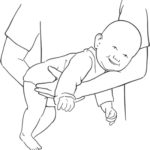In 2013 I found myself in an infant craniosacral training in Portland, Oregon with Carol Gray, a leader in the field of pediatric bodywork. Prior to this training, I thought I knew a lot about the basics of baby care and development having been a busy birth doula and having served families during the perinatal time in several capacities. Wow, I was wrong! My eyes opened to a story unfolding that I had no idea about prior to becoming a pediatric bodyworker.
Tummy for Play
There was a public health initiative in 1992 called Back to Sleep which was very successful in getting parents to do several things: have babies sleep in safe sleep environments without puffy bedding and stuffed animals, and have babies sleep on their backs. Because experts knew there may be developmental impacts from not allowing babies to sleep on their bellies, another initiative started concurrently called Tummy for Play. Tummy for Play was not promoted as thoroughly as Back to Sleep, and still to this day, the message often does not get out to care providers effectively or to parents. Back sleeping, in combination with many babies having several hours a day in car seats, swings and other baby devices, lends itself to a situation where babies are not getting their basic needs for movement and variation in positions met.
The impact of this is significant, as we have seen the rates of plagio and brachiocephaly (flat spots on baby’s heads) rise at a 200% increase with around 46.6% of the baby population having some level of plagio or brachiocephaly according to one Canadian study. Research also tells us that consistent tummy time is associated with improved motor development. Four-month-old babies who spent at least 30 waking minutes on their tummies scored higher on developmental tasks when compared to babies who did not.
Carol’s training, and the new knowledge of our cultural need for tummy time and movement for babies, led me to further studies with a brilliant craniosacral and occupational therapist, Michelle Emanuel. She is the developer of the Tummy Time Method, a scientific, evidence informed program developed to uniquely address the needs of babies in the newborn to pre crawling stage of life. The program attunes to baby’s calm and relaxed state and healthy nervous system function with a focus on connection with parents during tummy time. I witnessed how powerful the method is with my own daughter, and continue to witness it’s impact in my bodywork practice as a Tummy Time Method professional. My greatest hope is that in sharing this information, you can experience a taste of the Tummy Time Method and weave it’s elements into you and your baby’s lives.
We know that in skill acquisition, one skill stacks on top of the other. We have also seen a rise in sensory processing and learning differences since the early 90’s. Tummy time is like the foundation of a house or the roots of a tree, it provides a strong foundation for all other sensorimotor development to unfold. There are many factors in every individual family unit, and like everything else, how a baby and child grows is completely multi-factorial. Some children have different needs and gifts to give our world, and deserve to always be supported in their unique and valuable trajectories. With an intentional shift of focus on tummy time and dynamic movement in the first year of life, we are giving our children a huge gift! Core strength and postural balance are gifts that we can give our children that will stay with them throughout their whole life span.
Tummy Time Begins at the Breast
Tummy time begins with the breast crawl and skin to skin. Laid back breastfeeding is also a form of tummy time. All babies who have challenges with breastfeeding and latching benefit from more intentional tummy time, as it helps strengthen the neck and jaw, as well as initiate all the reflexes needed for efficient nursing. Napping in tummy time on an adult is medicine for the nervous system and brain, while also supporting bonding and breastfeeding. As a baby grows, tummy time is a time for play, connection and fun with parents, siblings and pets.
Tummy Time How-To
A key element of the Tummy Time Method is going slowly and following your baby’s cues. Slowly set your baby on the floor on his or her back, connect, and slowly roll your baby onto their tummy. Connect with them there with eye contact and your voice. They will naturally orient their heads towards one direction. By then getting on the other side and talking with your baby, you encourage them to practice full neck range of motion, eye and auditory tracking and more. Look for signs that your baby wants to get out of tummy time before they get upset. Slowly roll them out. Pick them up if needed, hold them heart to heart, and then do it again! Make it fun and focus on the positive. Every day when my husband got home from work, he sprawled out on the floor with my daughter for some serious tummy time play. My daughter had torticollis so we also had target goals we were working towards. If your baby enjoys tummy time for 30 seconds, make that an awesome 30 seconds! You ill likely see the amount of time lengthen as your baby gets more practice.
Here are a few tips to make tummy time easy and fun for your family, and to encourage optimal development:
- Get connected to the Tummy Time!™ Method community! Follow the Instagram account @tummytimemethod and get the details of the method here. If you are a professional (doula, lactation specialist, bodyworker, etc.) working with babies, you can also look into becoming a Tummy Time!™ Method professional on the website!
- Integrate it into your daily routines by rolling baby in tummy time after each diaper change. Sessions do not have to be long, little doses here and there add up quickly.
- Wear your baby with intention. While baby wearing does not meet all of babies’ needs for tummy time, it has some overlapping benefits and provides babies with a variety of positions throughout the day. For the hardcore baby-wearers out there, if you back carry and do activities like gardening or cleaning the floor while on all fours, babies get super tummy time that way!
- Make spaces in your home for intentional tummy time and floor time. You can start this with your baby as early as you want, however, babies usually enjoy tummy time the best on a parent or adult in the first few weeks of life. All you need for tummy time is a comfy blanket on the floor and space for parents/siblings/pets to join in.
- Encourage floor time instead of containers like swings, jumpers, exersaucers etc, when possible. Parenting is hard! Some of these items can be used mindfully and in moderation without negative side effects, especially when paired with enough free movement and tummy time. However, they are really best to avoid altogether if possible. Ideally, use car seats for car rides only.
- The tiger in the tree hold! My daughter was often uncomfortable in her first few months of life with tummy upsets and reflux. She loved this position and I would carry her around the house like this often.
- Refrain from “teaching” babies to sit with rigid baby seats like the bumbo, trust that with enough tummy time, babies will get into transitional poses on their own when they have developed enough strength. Restrictive baby seats can teach young babies to recruit different muscles for sitting before they are ready, which can inhibit core strength development and cause postural imbalances. If you would like to use a seat for your baby, choose a softer option like the Fisher Price sit me up seat, or use a laundry basket stuffed with blankets and pillows!
- Know that intentional tummy time prepares babies for the most exciting milestone in my opinion, crawling! Crawling is medicine for the brain and body (this is true for adults, too!), so encourage it for as long as possible, even after children start walking! It is literally never too late to learn to crawl, if you or your child skipped this milestone.
- Seek additional information. If after some practice, you suspect that your baby is truly uncomfortable in tummy time, consider a consultation with me for craniosacral therapy and a Tummy Time Method consult. Babies with soft tissue restrictions or lack of experience with tummy time may benefit from some additional help.
Life isn’t a matter of milestones, but of moments. – Rose Kennedy




